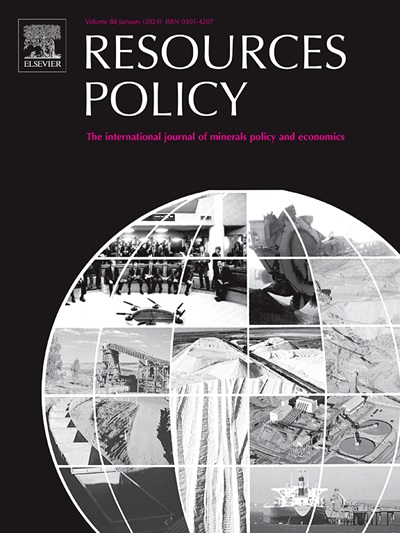能源-金属-股票-碳市场之间的因果关系、关联性和波动传递:来自欧盟的新证据
IF 10.2
2区 经济学
0 ENVIRONMENTAL STUDIES
引用次数: 0
摘要
欧盟碳市场是一种创新的金融工具,其主要目标是减轻气候变化的影响。该市场与化石能源、贵金属和金融市场之间存在着显著的相互联系,但有关时变溢出效应的因果关系、依赖性、强度和方向的研究却十分有限。本研究探讨了能源、金属和金融市场如何对欧盟碳市场产生影响。它主要研究三个问题,即1) 这些市场如何相互影响?通过回答这些问题,本研究旨在协助欧盟决策者制定有效的碳政策,帮助投资者管理风险,并推广符合欧盟气候目标的做法。为了实现这些目标,本文提出了一种新颖的方法论,即结合最新的计量经济学方法,如定向循环图分析、Canonical Vine Copula 模型和具有随机波动性的时变参数向量自回归模型,并使用 2005 年 4 月 26 日至 2022 年 12 月 31 日的每日数据综合样本。本研究的主要发现表明,因果关系主要是从能源、金属和金融市场到欧盟碳市场。尽管在不同的子时期,因果关系结构各不相同,但石油、煤炭、白银、铜、EuroStoxx600 和二氧化碳市场之间的因果关系非常密切。此外,石油和铜期货价格对 EUA 价格的依赖程度最高。此外,研究还发现,欧盟碳市场是所有其他市场冲击的净接收者,能源、金属和金融市场对欧盟碳市场价格的波动有显著影响。滞后一天的时变溢出效应最为明显,溢出效应的持续时间从 2 天到 15 天不等,随着时间的推移逐渐减弱。这些结果有可能加深人们对欧盟碳市场的理解,并为该领域的政策制定者、投资者和企业提供实用指导。本文章由计算机程序翻译,如有差异,请以英文原文为准。

Causality, Connectedness, and Volatility pass-through among Energy-Metal-Stock-Carbon Markets: New Evidence from the EU
The EU carbon market serves as an innovative financial instrument with the primary objective of contributing to mitigating the impacts of climate change. This market demonstrates significant interconnectedness with fossil energy, precious metal, and financial markets, although limited research has focused on the causality, dependency, intensity and direction of time-varying spillover effects. This study examines how the energy, metal, and financial markets have an impact on the EU carbon market. It focuses on three main research questions, namely: 1) how do these markets affect each other?; 2) how do they connect?; 3) how do volatilities spillover among them? By answering these questions, the study aims to assist EU decision makers to develop effective carbon policies, help investors manage risks and promote practices that are consistent with the EU's climate goal. To achieve these objectives, this paper proposes a novel methodological approach that combines the most recent econometrics methods, such as Directed Acyclic Graph analysis, Canonical Vine Copula models, and Time-Varying parameter Vector Auto Regressive models with Stochastic Volatility with the use of a comprehensive sample of daily data from April 26, 2005 to December 31, 2022. The major findings of this study demonstrate that causality predominantly runs from energy, metal, and financial markets to the EU carbon market. The dependency structure, although varying across different sub-periods, shows a strong relationship observed between oil, coal, silver, copper, EuroStoxx600, and market. Additionally, the oil and copper futures prices exhibit the highest dependence on EUA prices. Furthermore, the study establishes that the EU carbon market is a net receiver of shocks from all other markets, with the energy, metal, and financial markets significantly influencing volatility in EUA prices. The time-varying spillover effect is most pronounced with a one-day lag, and the duration of the spillover effects ranges from 2 to 15 days, gradually diminishing over time. These results have the potential to increase the understanding of the EU carbon market and offer practical guidance for policymakers, investors, and companies involved in this domain.
求助全文
通过发布文献求助,成功后即可免费获取论文全文。
去求助
来源期刊

Resources Policy
ENVIRONMENTAL STUDIES-
CiteScore
13.40
自引率
23.50%
发文量
602
审稿时长
69 days
期刊介绍:
Resources Policy is an international journal focused on the economics and policy aspects of mineral and fossil fuel extraction, production, and utilization. It targets individuals in academia, government, and industry. The journal seeks original research submissions analyzing public policy, economics, social science, geography, and finance in the fields of mining, non-fuel minerals, energy minerals, fossil fuels, and metals. Mineral economics topics covered include mineral market analysis, price analysis, project evaluation, mining and sustainable development, mineral resource rents, resource curse, mineral wealth and corruption, mineral taxation and regulation, strategic minerals and their supply, and the impact of mineral development on local communities and indigenous populations. The journal specifically excludes papers with agriculture, forestry, or fisheries as their primary focus.
 求助内容:
求助内容: 应助结果提醒方式:
应助结果提醒方式:


